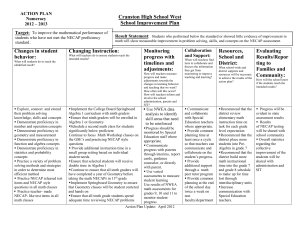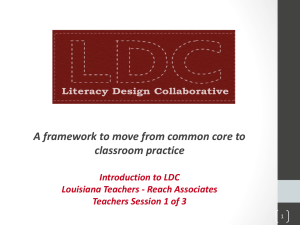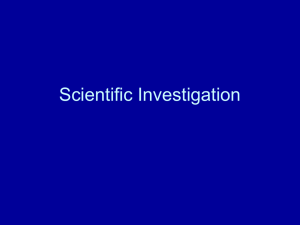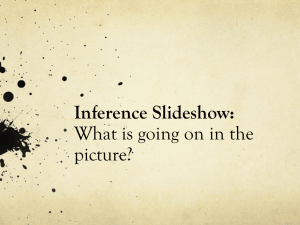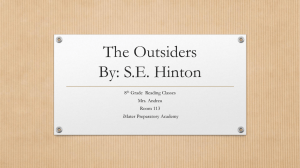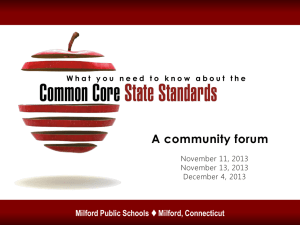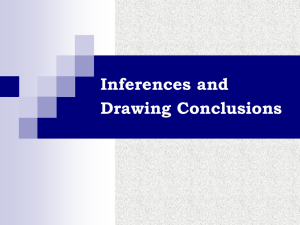the Faculty Common Core PowerPoint
advertisement
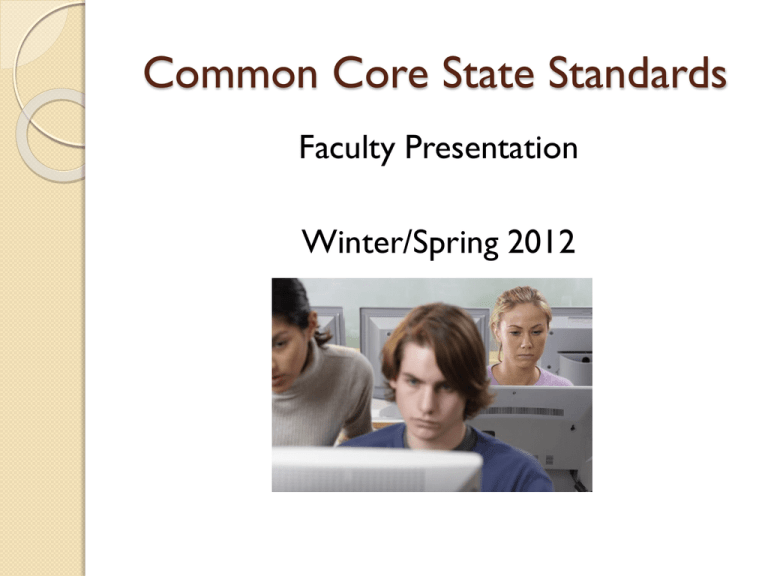
Common Core State Standards Faculty Presentation Winter/Spring 2012 Common Core State Standards What do I need to know? 2010-2011 2011-2012 2012-2013 2013-2014 2014-2015 Faculty presentation- Spr’12 What’s Different about the Common Core State Standards? Started with the end in mind (College and Career Readiness) Increased the rigor – raised the bar Goes deeper – not wider They are common to (almost) all the states! Turn and Talk…. In groups of 2 or 3, each share: One thing you wonder about the Common Core One thing that you are concerned about the Common Core Put your group’s stickies on charts. Over 1,300 students did NOT graduate from Vermont high schools in 2010. The lifetime wages loss for those students is $300 MILLION. In Vermont, for every 100 9th graders: 85 will graduate high school In Vermont, for every 100 9th graders: 44 will enter college the following fall In Vermont, for every 100 9th graders: 33 will return for their second year In Vermont, for every 100 9th graders: 26 will receive a degree within 150% of normal time Jobs Require More Education & Training Today and Tomorrow 100% 90% 80% 70% 60% 50% 40% 30% 20% 10% 0% 7% 9% 12% 10% 11% 10% 19% 21% 23% 8% 40% 10% 12% 17% 17% 34% 30% 28% 10% 11% 10% 1992 2007 2018 19% 32% 1973 High school dropouts High school graduates Some college, no degree Associate's degree Bachelor's degree Master's degree or better Source: Carnevale, Anthony P., Nicole Smith, and Jeff Strohl, “Help Wanted: Projections of Jobs and Education Requirements Through 2018”, Georgetown Center on Education and the Workforce, 2010. almost 2/3 Teaching to Higher Levels of Rigor Educators need to have a ‘growth mindset’ rather than a ‘fixed mindset’. Teachers with a fixed mindset believe that what the teacher does matters very little – one is either smart or not. Teachers with a growth mindset believe intelligence can be developed with the right support and instruction. Studies by Carol Dweck show that when students are taught that the brain is a muscle that should be exercised to get stronger, students persist through challenges they would typically give up on. Teaching to Higher Levels of Rigor Educators need to explicitly teach thinking. Teachers should explain the levels of thinking and engage students in lessons that require them to compare and contrast, analyze, synthesize, evaluate, judge, defend. Teachers use the ‘think-aloud’ model to show students what happens in the brain of a person using those skills. Students then need to practice those skills and share their thinking until those processes become automatic. “The most important reforms that a school system can make will be those that involve creating systems that support continuous improvement of instruction and increased personal and shared accountability for raising levels of student achievement.” Lucy Calkins Teachers Matter! The effect of the teacher overshadows other classroom variables such as: Previous achievement level of students Class size Heterogeneity of students Ethnic and Socioeconomic makeup of the classroom Curricula A teacher’s effect on student achievement is measurable years after the students have left that teacher. VMI/Laird presentation Focus on Shifts in Instructional Practice 2011-2013 What have we learned so far? Take the time to get to know it. Common Core: ELA, Literacy & Math Standards – we are in sync! Common Core State Standards: English Language Arts K-12 Strands and organizing elements Reading Writing (W) K-12 Literature (RL) K-12 Text types and purposes Key ideas and details Production and distribution of writing Craft and structure Research to build and present knowledge Integration of knowledge and ideas Range of Writing Range of reading and level of text complexity Informational Text (RI) K-12 Speaking & Listening (SL) K-12 Key ideas and details Comprehension and collaboration Craft and structure Presentation of knowledge & ideas Integration of knowledge and ideas Range of reading and level of text complexity Foundational Skills (RF) K-5 only Language (L) K-12 Conventions of Standard English Print Concepts Knowledge of Language Phonic and word recognition Vocabulary Acquisition and Use Phonological Awareness Fluency Common Core Foundational Reading Standards K-5 Print Concepts Phonological Awareness Phonics and Word Recognition Fluency These standards focus on concepts of print, the alphabetic principle, and other basic conventions that are necessary for a comprehensive reading program across disciplines. Common Core Reading Standards There are 9 standards focused on reading comprehension and one on the range and level of text complexity for literature and informational text. The reading standards are broken into: Key ideas and details Craft and structure Integration of knowledge and ideas Range of reading and level of text complexity Claim 1: Read closely and analytically to comprehend increasingly complex informational texts. Grade Key Ideas and Details 11-12 RI. 1 Cite strong and thorough textual evidence to support analysis of what the text says explicitly as well as inferences drawn from the text, including determining where the text leaves matters uncertain. 9 -10 RI. 1 Cite strong and thorough textual evidence to support analysis of what the text says explicitly as well as inferences drawn from the text. 8 RI. 1 Cite the textual evidence that most strongly supports an analysis of what the text says explicitly as well as inferences drawn from the text 7 RI. 1 Cite several pieces of textual evidence to support analysis of what the text says explicitly as well as inferences drawn from the text RI. 1 Cite textual evidence to support analysis of what the text says explicitly as well as inferences drawn from the text 6 5 RI. 1 Quote accurately from a text when explaining what the text says explicitly and when drawing inferences from the text. 4 RI. 1 Refer to details and examples in a text when explaining what the text says explicitly and when drawing inferences from the text. RI. 1 Ask and answer questions to demonstrate understanding of a text, referring explicitly to the text as the basis for the answers. RI.1 Ask and answer such questions as who, what, where, when, why, and how to demonstrate understanding of key details in a text. RI.1 Ask and answer questions about key details in a text. Independence RI.1 With prompting and support, ask and answer questions about key details in a text. 3 2 1 K RI.2 Determine two or more central ideas of a text and analyze their development over the course of the text, including how they interact and build on one another to provide a complex analysis; provide an objective summary of the text. RI.2 Determine a central idea of a text and analyze its development over the course of the text, including how it emerges and is shaped and refined by specific details; provide an objective summary of the text. RI.2 Determine a central idea of a text and analyze its development over the course of the text, including its relationship to supporting ideas; provide an objective summary of the text. RI.2 Determine two or more central ideas in a text and analyze their development over the course of the text; provide an objective summary of the text. RI.2 Determine a central idea of a text and how it is conveyed through particular details; provide a summary of the text distinct from personal opinions or judgments. RI.2 Determine two or more main ideas of a text and explain how they are supported by key details; summarize the text. RI.2 Determine the main idea of a text and explain how it is supported by key details; summarize the text. RI.2 Determine the main idea of a text; recount the key details and explain how they support the main idea. RI.2 Identify the main topic of a multi-paragraph text as well as the focus of specific paragraphs within the text. RI.2 Identify the main topic and retell key details of a text. Independence RI.2 With prompting and support identify the main topic and retell key details of a text. Grade Key Ideas and Details ANCHOR 1. Read closely to determine what the STANDARD text says explicitly and to make logical inferences from it; cite specific textual evidence when writing or speaking to support conclusions drawn from the text. 11-12 RI. 1Cite strong and thorough textual evidence to support analysis of what the text says explicitly as well as inferences drawn from the text, including determining where the text leaves matters uncertain. 9-10 RI. 1Cite strong and thorough textual evidence to support analysis of what the text says explicitly as well as inferences drawn from the text. 8 7 6 5 2. Determine central ideas or themes of 3. Analyze how and why individuals, a text and analyze their development; events, and ideas develop and interact summarize the key supporting details over the course of a text. and ideas. RI.2 Determine two or more central ideas of a text and analyze their development over the course of the text, including how they interact and build on one another to provide a complex analysis; provide an objective summary of the text RI.2 Determine a central idea of a text and analyze its development over the course of the text, including how it emerges and is shaped and refined by specific details; provide an objective summary of the text. RI. 1 Cite the textual evidence that most RI.2 Determine a central idea of a text strongly supports an analysis of what the and analyze its development over the text says explicitly as well as inferences course of the text, including its drawn from the text relationship to supporting ideas; provide an objective summary of the text. RI. 1 Cite several pieces of textual RI.2 Determine two or more central ideas evidence to support analysis of what the in a text and analyze their development text says explicitly as well as inferences over the course of the text; provide an drawn from the text objective summary of the text. RI. 3 Analyze a complex set of ideas or sequence of events and explain how specific individuals, ideas, or events interact and develop over the course of the text. RI. 3 Analyze how the author unfolds an analysis or series of events, including the order in which the points are made, how they are introduced and developed, and the connections that are drawn between them. RI.3 Analyze how a text makes connections among and distinctions between individuals, ideas, or events (e.g. through comparisons, analogies, or categories). RI.3 Analyze the interactions between individuals, events, and ideas in a text (e.g. how ideas influence individuals or events, or how individuals influence ideas or events). RI. 1 Cite textual evidence to support RI.2 Determine a central idea of a text RI.3 Analyze in detail how a key analysis of what the text says explicitly and how it is conveyed through particular individual, event, or idea is introduced, as well as inferences drawn from the text details; provide a summary of the text illustrated, and elaborated in a text (e.g. distinct from personal opinions or through examples and anecdotes). judgments. RI. 1 Quote accurately from a text when RI.2 Determine two or more main ideas RI. 3 Explain the relationships or explaining what the text says explicitly of a text and explain how they are interactions between two or more and when drawing inferences from the supported by key details; summarize the individuals, events, ideas, or concepts in Throughout the Common Core, tremendous emphasis is placed on students’ ability to closely read and interact with increasingly challenging literature and informational text. Appendix A: complete discussion about why text complexity matters Appendix B: provides text exemplars and sample performance tasks to illustrate the complexity, quality, and range of student reading and application at various grade levels Appendix A Appendix B A Shift in Balance….. Literary Informational Elementary 50% 50% Middle 45% 55% High School 30% 70% Students read a true balance of informational and literary texts – even in elementary school accessing the world of science, social studies, the arts and literature through text. How to Read the Reading Standards…. -Strand -Organizing Element -Grade Level Column -Standard Writing Standards The writing standards are designed around: Text Types and Purposes Production and Distribution of Writing Research to Build and Present Knowledge Range of Writing over short and extended time frames. Appendix C: provides extensive samples of student writing that convey an understanding of adequate performance levels in writing arguments, informational/explanatory texts and narratives across the grades. They are annotated. Appendix C Instruction Shifts for CCSS Writing: Focus on nonfiction writing (arguments as well as informational/explanatory texts) in all disciplines! Ability to conduct research in short and longer projects To Persuade To Explain To Convey Experience Elementary 30% 35% 35% Middle 35% 35% 30% High School 40% 40% 20% Tremendous value is placed on growing analytical thinkers and critical consumers and providing tools and structures for students to express their voice orally and in writing. Speaking and Listening Standards Comprehension and collaboration Presentation of knowledge and ideas Both of the above themes reinforce 21st century skills in establishing the importance of effective oral communication and collaborative discussion to build understanding and solve problems. Common Core State Standards: Literacy in History/Social Studies, Science, and Technical Subjects – Grades 6-12 Strands and organizing elements Reading Writing Key ideas and details History/Social Studies, Science, and Technical subjects (WHST) 6-12 Craft and structure Integration of knowledge and ideas Range of reading and level of text complexity Text types and purposes Production and distribution of writing Research to build and present knowledge Range of writing History/Social Studies (RH) 6-12 Science and Technical Subjects (RST) 6-12 Key ideas and details Craft and structure Integration of knowledge and ideas Range of reading and level of text complexity The Entire School’s Core…. The design and organization of the standards support literacy instruction as a shared responsibility within the school. This integrated approach to literacy promotes relevant, real-world application of students’ reading and writing skills as they analyze, evaluate and differentiate between primary and secondary sources and communicate key ideas and concepts. Common Core State Standards: Math Standards for mathematical practices Standards for mathematical content K-8 Standards for mathematical content for high school. Appendix A: extensive overview of units of study in high school for either a traditional model or integrated high school course sequence Appendix A-Math Common Core Math Standards Emphasis on mathematical practices and spotlight equal attention on developing understanding of core concepts and fluency with procedural skills They are written to assume mastery, in any given year, of the preceding year’s standards. Relationships Between Practices Overarching Habits of Mind (Dispositions of an educated person within and outside mathematics) 1) Make sense of problems and persevere in solving them 6) Attend to precision 3) Construct viable arguments and critique the reasoning of others Using Mathematics Inside and Outside of School 4) Model with mathematics 5) Use appropriate tools strategically 2) Reason abstractly and quantitatively Skills Needed to Work with and to Learn Mathematics 7) Look for and make use of structure 8) Look for and express regularity in repeated reasoning VMI/Laird Common Core Standards for Mathematics: Content Standards K-5 __________________________________________________ Teach More of Less Standards for Mathematical Content Number and Operations Where the Rigor is! Standards for Mathematical Practice Operations and Algebraic Thinking Common Core Standards for Mathematics: Content Standards 6-8 ____________________________________________________ Transitional Years Standards for Mathematical Content Aggressive Progression to Algebra Standards for Mathematical Practice Ratios and Proportions Expressions, Equations, & Functions Common Core Standards for Mathematics: Content Standards High School __________________________________________________________ _ College and Career Ready Standards for Mathematical Content Advanced Standards Application Standards for Mathematical Practice Modeling More proportionality Content Shifts – Less is More Most Existing State Standards Number Concepts, Operations, and Fluency K 1 2 3 4 5 No 3-D geometry at grades 3 and 4 Data linked to measurement or number concepts Marge Petit Consulting, MPC margepetit.com 802-496.4651 6 Linear Functions and intro to non-linear 7 8 HS Counting techniques Probability Statistical analysis Similarity Transformations 43 Coherence across grades Marge Petit Consulting, MPC margepetit.com 802-496.4651 44 High School Standards – 2 sets All students Students taking advanced math courses (+) Marge Petit Consulting, MPC margepetit.com 802-496.4651 45 3 All rational number operations 2 All positive fraction and decimals operations 1 All whole number operations K All whole number –add and subtract An Emphasis on Procedural Fluency Procedural fluency “refers to the knowledge of procedures, knowledge of when and how to use them appropriately, and skill in performing them flexibly, accurately and efficiently.” (Adding It Up! NRC (2000)) 4 5 6 7 Marge Petit Consulting, MPC margepetit.com 802-496.4651 8 HS 46 How to Read Math Standards Domains (larger groups of related standards) Clusters (within domains – related standards) Standards (define what students should understand and be able to do) Another way to look at the timeline 2011/12 2012/13 2013/14 2014/15 3 NECAP NECAP NECAP SBAC 4 NECAP NECAP NECAP SBAC 5 NECAP NECAP NECAP SBAC 6 NECAP NECAP NECAP SBAC 7 NECAP NECAP NECAP SBAC 8 NECAP NECAP NECAP SBAC NECAP NECAP NECAP SBAC K 1 2 9 10 11 12 Turn and Talk…. In groups of 2 or 3, each share: One thing you wonder about the assessment (SBAC) One thing that you are concerned about the assessment Put your group’s stickies on charts. Smarter Balanced Assessment Consortium http://www.smarterbalanced.org/ The SBAC – assessment system including summative, interim and formative components – is aligned with the Common Core State Standards and will accurately measure student achievement and growth toward college and career readiness. http://www.smarterbalanced.org/smarter-balanced-assessments/ Computer Adaptive Testing Based on student responses, the computer program adjusts the difficulty of questions throughout the assessment. Better information for teachers More efficient and more secure More accurate Nimble Tools has a site where you can test out sample items online! http://nimbletools.com/demo/index.htm Suggested Next Steps….. Read the CORE -your grade level -the one before and after your level -the Introduction - the Appendices Suggested Next Steps…. Look at your current practice and incorporate or learn about a new instructional strategy aligned with the Common Core….. ELA MATH Text Complexity Informational Text Academic Vocabulary Short Consistent Research Argument/Evidence Use of Multiple Texts Content Shifts Embedding the Practice Standards in Lessons Math Modeling Procedural Fluency Additive Reasoning Summer Opportunities Math: K2 – Laying the Foundation (Tuttle) Aug 13-17 Early Grades - Building Upon the Foundation (TBA) Aug 13-17 Gr 3-5 – Dig Into Practices and CC Standards June 25-29 Gr 6-8 – Dig Into Practices and CC Standards Aug 6-10 High School Math & Common Core June 21-22 Summer Opportunities ELA Common Core Literacy Institute Frederick Tuttle Middle School – Aug 13-15 Strands include: Supporting the Transition – Building Leaders Teaching with Nonfiction Connections: Effective Discussions and Writing Claims (ELA through Science) Non-fiction Reading and Writing Vocabulary Development Moving from Persuasion to Argument Questions? This combines the work of VT DOE Common Core presentations, CommonCore.org, Marge Petit, SmarterBalanced.org, Navigating Implementation of the Common Core – Doug Reeves, and Lauren Wooden –CESU, Kerry Sewell - MTSD
